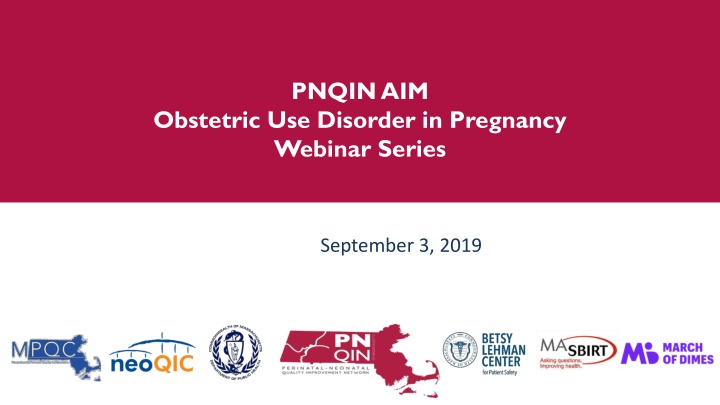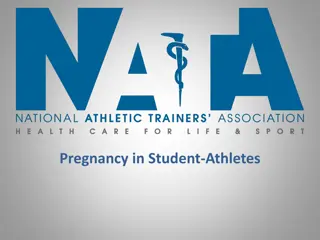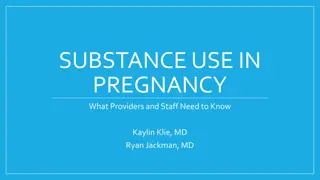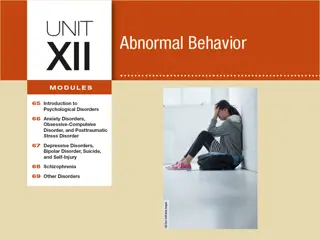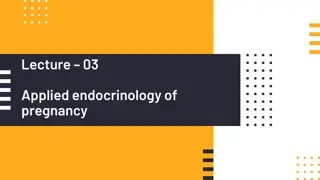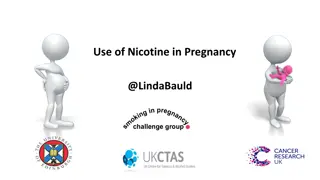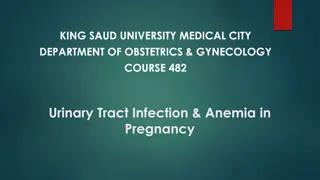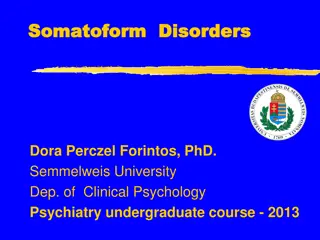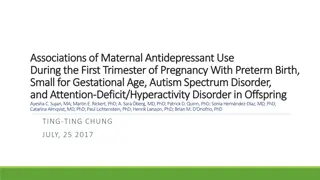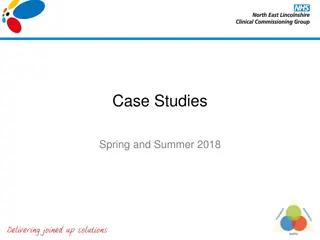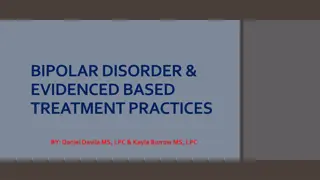PNQIN.AIM Obstetric Use Disorder in Pregnancy Webinar Series
Join the Perinatal-Neonatal Quality Improvement Network of Massachusetts for their monthly webinar series focused on Obstetric Use Disorder in Pregnancy. The sessions include updates on quality improvement projects, brief teaching assignments, guest presentations, and closing remarks. Attendees are encouraged to participate actively, use the chat box for questions and comments, and follow webinar housekeeping guidelines for a smooth session. Hospital leadership teams from various institutions are actively engaged in the program.
Download Presentation

Please find below an Image/Link to download the presentation.
The content on the website is provided AS IS for your information and personal use only. It may not be sold, licensed, or shared on other websites without obtaining consent from the author.If you encounter any issues during the download, it is possible that the publisher has removed the file from their server.
You are allowed to download the files provided on this website for personal or commercial use, subject to the condition that they are used lawfully. All files are the property of their respective owners.
The content on the website is provided AS IS for your information and personal use only. It may not be sold, licensed, or shared on other websites without obtaining consent from the author.
E N D
Presentation Transcript
PNQIN AIM Obstetric Use Disorder in Pregnancy Webinar Series September 3, 2019 PERINATAL-NEONATAL QUALITY IMPROVEMENT NETWORK OF MASSACHUSETTS
OUD in Pregnancy Webinars Monthly Agenda Overview 12:00 - 12:05: Welcome/ Introductions 12:05 - 12:15: Updates from the teams on QI projects + collaborative 12:15 - 12:30: Brief QI teaching, Assignment 12:30 - 12:55: Guest Topics 20 minute presentations + 5 mins for questions 12:55 - 1:00: Closing/ Final Comments PERINATAL-NEONATAL QUALITY IMPROVEMENT NETWORK OF MASSACHUSETTS
WebEx Housekeeping Attendee ID Audio Mute PERINATAL-NEONATAL QUALITY IMPROVEMENT NETWORK OF MASSACHUSETTS
Webinar Housekeeping When signing into WebEx use your attendee ID number so your name shows up on the participant list with the correct phone line We will take attendance in the chat box each month please comment with your name, role, and hospital Please mute your lines and avoid placing us on hold, as we will hear your hold music sometimes beautiful, but also distracting When speaking, remember to unmute (click red microphone and your own personal line as well) Please use the chat box freely to ask questions and provide comments We will be recording each session and placing slides on our website after the call We welcome feedback, suggestions about the webinar content and structure Please participate! We want this to be helpful and collaborative! PERINATAL-NEONATAL QUALITY IMPROVEMENT NETWORK OF MASSACHUSETTS
PNQIN AIM OUD Wave 1 Hospital Leadership Teams: Who s on the line UMASS Memorial Medical Center Katherine Callaghan Mark Manning Metrowest Medical Center Sandy Harmon Debbie Durgin Joan Eilers Jason Laviolette Steven Solano Milford Regional Medical Center Rose Galimi-Hayes Brittany Weber Kim Sullivan Amy Madden Pamela Rosado Newton-Wellesley Hospital Lisa Dunn-Albanese North Shore Medical Center Allyson Preston Alex Kochowiec Marcella Burrows Caroline Siefken South Shore Hospital Christina Just Leal Lyons Pam Patterson Julie Paul Tufts Medical Center Alexandra Spadola Audrey Power Victoria Wang Cape Cod Hospital Jen Gilbert Jodi Belson Jean MacBarron Catherine Thompson Cooley-Dickinson Hospital Amy Walker Emerson Hospital Jeffrey Riley Fairview Hospital Joan Pezzano Andrew Beckwith Jennifer Dallmeyer Falmouth Hospital Jennifer LaCasse Jen Gilbert Lowell General Hospital Kristin Dorsi Kathy Mahoney Liz Lydstone Massachusetts General Hospital Erik Clinton Kim Francis Mercy Medical Center Rebecca Brushwood Stephanie Martin-Lucey Anna Jaques Hospital Mary Chang Alison Sekelsky Baystate Franklin Medical Center Julie Thompson Linda Jablonski Baystate Medical Center Andrew Healy Donna Jackson-Kohlin Megan Miller Sharon Holley Donna Stafilarakis Rachana Singh Connie Blake Berkshire Medical Center Kathleen Sheridan Kim Beisiegel Melissa Canata Beth Israel Deaconess Medical Center Chloe Zera Brett Young Sara Tong Boston Medical Center Kelly Saia Porsha Eden Brigham and Women's Hospital Nicole Smith Audra Meadows Leena Mittal Non-Hospital Affiliated Team Members Laura Sternberger Any Sorenson-Alawad Deborah Stolbach Hannah Kloomok Debra Bercuvitz Carolyn Castro-Donlan Bonnie Glass FiFi Diop Keturah Edwards Melissa Abell-Bardsley Jen Moffitt Judith Hahn Julia Reddy Emma Trucks Jennifer Seaberg Alex Heinz Alissa Cruz PERINATAL-NEONATAL QUALITY IMPROVEMENT NETWORK OF MASSACHUSETTS
PNQIN Perinatal Opioid Project Leadership Team PNQIN Neonatal Folks Elisha Wachman (BMC) Larry Rhein (UMass) Rachana Singh (Baystate) Davida Schiff (MGH) Alan Picarillo (Maine) Eileen Costello (BMC) Maternal Folks Katherine Callaghan (UMass) Leena Mittal (MCPAP for Moms) Laura Sternberger (Moms Do Care) Nicole Smith (BWH) Donna Jackson-Kohlin (Baystate) Linda Jablonski (Baystate) Academic and Organizational Partners Patrice Melvin (BCH) Karla Damus (BU) Christina Gebel (MOD) State Partners Fifi Diop (DPH and PI of PNQIN Grant) Griffin Jones (HPC) Michael Kelleher (OHHS) Debra Bercuvitz (DPH) Abby Taylor (AGO) Karen Pressman (BSAS) Julia Reddy (BSAS) Mary Lutz (DCF) Alissa Cruz (MassBIRT) Colleen Labelle (BMC) Julia Prentice (BLC) Natalia Ciesielska (BLC) Families Patricia McDonnell (Baystate) Julie Maida Meghann Perry Cieara McManus (Moms Do Care) Fifi Diop (DPH) Audra Meadows (BWH) Ron Iverson (BMC) Breanna Chachere (BMC) Mary Houghton (BIDMC) Munish Gupta (BIDMC) PERINATAL-NEONATAL QUALITY IMPROVEMENT NETWORK OF MASSACHUSETTS
Team Updates/Check-In PERINATAL-NEONATAL QUALITY IMPROVEMENT NETWORK OF MASSACHUSETTS
PNQIN Perinatal Opioid Data Collection PERINATAL-NEONATAL QUALITY IMPROVEMENT NETWORK OF MASSACHUSETTS
Team Updates PERINATAL-NEONATAL QUALITY IMPROVEMENT NETWORK OF MASSACHUSETTS
QI Webinar Topics for Next 12 months Date 7/9/19 8/6/19 9/3/19 10/1/19 11/5/19 12/3/19 1/7/20 2/4/20 3/3/20 4/7/20 5/5/20 6/2/20 QI Topic OUD Bundle Components Overview Stakeholders Developing a Project AIM Measures for Improvement Key Driver Diagram Developing interventions Understanding Run Charts Understanding Data Control Charts Using the PDSA Cycle PDSA: Making Adjustments Scale and Spread Up Sustainability PERINATAL-NEONATAL QUALITY IMPROVEMENT NETWORK OF MASSACHUSETTS
QI Teaching: Developing AIM Statements Bonnie Glass, RN, MN PERINATAL-NEONATAL QUALITY IMPROVEMENT NETWORK OF MASSACHUSETTS
Setting the Stage Developing a Project Aim Bonnell Glass, RN, MN Adapted from Kristen Leeman, MD Boston Children s Hospital
How do you we pick a topic? What can we do better?
How do you we pick a topic? What can we do better? Is there a process that could be more efficient?
How do you we pick a topic? What can we do better? Is there a process that could be more efficient? Is there a way to deliver care more safely?
How do you we pick a topic? What can we do better? Is there a process that could be more efficient? Is there a way to deliver care more safely? Is there a way to reduce excess steps in a process?
How do you we pick a topic? What can we do better? Is there a process that could be more efficient? Is there a way to deliver care more safely? Is there a way to reduce excess steps in a process? Is there something we can modify that would make patients, their families or staff happier?
How do you we pick a topic? What can we do better? Is there a process that could be more efficient? Is there a way to deliver care more safely? Is there a way to reduce excess steps in a process? Is there something we can modify that would make patients, their families or staff happier? Is there an opportunity to improve patient outcomes?
How do you we pick a topic? Safety Patient Centered Efficiency Effectiveness Equity 2001, Crossing the Quality Chasm: A New Health System for the 21st Century: Timeliness IOM Framework 6 overarching Aims for Improvement in Health Care
How do you we pick a topic? Safety Internally from drivers within your unit Individual cases Event reporting Patient Centered Efficiency Externally from comparing your performance with other centers 30,000 foot view Use of comparative data, benchmarking, can risk adjust VON, CHNC, NICHD NRN, MEDNAX database Effectiveness Equity Timeliness IOM Framework
Narrow the focus Review current practice, evidence-based data and perform practice comparison with centers that have Good problems can be common, modifiable, have readily available benchmarks, and are important to the team Joint Commission FINER framework can help narrow focus: Feasible Interesting Novel Ethical Relevant
Example When examining your center s Necrotizing Enterocolitis (NEC) rate compared to the VON network, you note your rate is significantly higher than the national benchmark. The team performs practice comparison with centers with low rates of NEC and notes that one difference is that those centers use donor milk in LBW infants when mother s milk is unavailable. The team then narrows their focus to increase the use of human milk in LBW infants by starting a donor milk program and test its affect over time
What are we trying to accomplish? Develop a SMART aim The key tool to clearly define your mission S M A R T
Develop a SMART aim The key tool to clearly define your mission SPECIFIC Is the statement precise about what the team is trying to achieve? M A R T
Develop a SMART aim The key tool to clearly define your mission Specific MEASURABLE A R T Are the outcomes measurable? Will you know if changes resulted in improvement?
Develop a SMART aim The key tool to clearly define your mission Specific Measurable ACHIEVABLE R T Related image Is this doable in the time you have? Are you attempting too much? Could you do more?
Develop a SMART aim The key tool to clearly define your mission Specific Measurable Achievable REALISTIC T Related image Do you have the resources needed?
Develop a SMART aim The key tool to clearly define your mission Specific Measurable Achievable Realistic TIMELY Related image Is the timeline identified?
Why is a SMART Aim important? Related image Clearly articulates the problem being address so that, when resolved, will provide meaningful value to the patients and organization Examination of current state can help define a starting point Provides a clear and specific goal for the team, succinct, specific Nothing will improve without a clear intention to do so precisely define your problem and your population Includes measurement to see if change led to improvement Team agreement on the AIM is crucial Can stimulate enthusiastic team support Important to allocate people and resources necessary to accomplish the AIM
Example A team noticed their NICU did not model compliant safe sleep practice in Level II babies nearing discharge to home. Initial Aim: To increase safe sleep practice in the NICU Not specific (who?, what?), measurable?, achievable?, realistic?, no time frame identified (over what time period?) SMART Aim: To increase rates of compliance with all elements of safe sleep in eligible level II NICU babies from a baseline of 50% to greater than 90% over a 12 month period
The stage is set! Identify a general area to improve Narrow the focus Develop a SMART aim
Exercises Draft a SMART Aim for a potential future improvement project using the IHI Worksheet that was sent to you
Guest Topics: Plans of Safe Care Julia Reddy, MA MA Department of Public Health PERINATAL-NEONATAL QUALITY IMPROVEMENT NETWORK OF MASSACHUSETTS
Closing Thoughts Next Webinar is Tuesday October 1 from 12p 1p QI Teaching: Measures for Improvement Guest Topic: Linkages to Care with Dr. Leena Mittal Homework: Continue working on AIM Statements for whichever project your team is working on Reminders for AIM OUD Wave 1 Contract: Complete Baseline and Structure Measure Surveys Send in Team Roster Submit invoices to Denise Henry when ready PERINATAL-NEONATAL QUALITY IMPROVEMENT NETWORK OF MASSACHUSETTS
Questions or Concerns? PERINATAL-NEONATAL QUALITY IMPROVEMENT NETWORK OF MASSACHUSETTS
